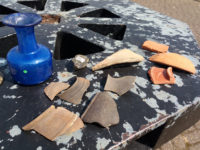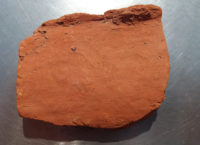 In a new addition to the annals of random people finding ancient artifacts, a sea kayaker has discovered pieces of Roman glass, pottery and tile off the coast of Ramsgate, Kent. The kayaker was in shallow water at low tide and with the clear day, he was able to just reach in and pick up the objects including a beautiful cobalt blue glass vase that looks like it could have been made yesterday, large pieces of high-end Samian ware pottery and a roof tile with a human fingerprint smudged on the surface.
In a new addition to the annals of random people finding ancient artifacts, a sea kayaker has discovered pieces of Roman glass, pottery and tile off the coast of Ramsgate, Kent. The kayaker was in shallow water at low tide and with the clear day, he was able to just reach in and pick up the objects including a beautiful cobalt blue glass vase that looks like it could have been made yesterday, large pieces of high-end Samian ware pottery and a roof tile with a human fingerprint smudged on the surface.
Mark Dunkley, a marine listing adviser with Historic England, said it was the sort of find which just did not happen in the UK. “It is the rarity of the material and the quality of the material that is really significant. In my experience this stuff just does not exist in an underwater context anywhere around Britain. It is a really significant find.”
The style of the artifacts dates them to the end of the first or beginning of the second century, a period when this area had two important Roman forts guarding the Wantsum Channel, a strait used by the Romans as a major trade route linking the English Channel and the Thames estuary.
 While it’s possible these objects could have washed to shore from an ancient shipwreck, it’s just as possible that they were discarded or buried along the shoreline but what was dry land then has now eroded into the coastline. Archaeologists from Historic England planned to explore the find site on Wednesday but the tides made it impossible. The revised plan is to investigate the location in August when the tides are more quiescent.
While it’s possible these objects could have washed to shore from an ancient shipwreck, it’s just as possible that they were discarded or buried along the shoreline but what was dry land then has now eroded into the coastline. Archaeologists from Historic England planned to explore the find site on Wednesday but the tides made it impossible. The revised plan is to investigate the location in August when the tides are more quiescent.
That stuff looks as if it had been ‘sandwiched’ in Sandwich Bay for ages, as ancient glass- and stoneware directly exposed to constant surf surge would look entirely different, i.e. much ‘(g)rounder’.
Archaeologists suggest that Sandwich and Pegwell Bay was the site of both the Roman invasions of Britain by Julius Caesar. In 2017 the University of Leicester excavated a large fort dating from 54 BC. Later, despite all efforts (e.g. newer forts!), of course, Anglo-Saxons managed to invade successfully.
By the way, on the other side of the channel, already in 1647, after heavy storms on the sandy beaches of Domburg (Zeeland, NL) a Roman sanctuary was discovered with dedications to Neptune, Mercury , but the majority to Nehalennia, a local female deity.
:hattip:
Apart from the blue vase, maybe somebody just dumped broken pots.
More Roman stuff from my corner of the world! What with the treacherous Godwin Sands not far offshore and the shallow sandy-wich bay, I would not be surprised if there were a wreck there. Wrecks appear and disappear all the time in this area.
The blue vase could easily pass as mid-century(20th!) Swedish.